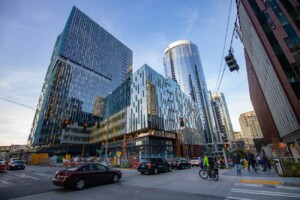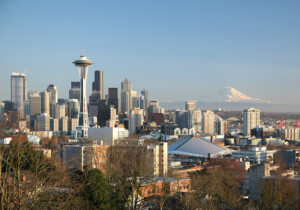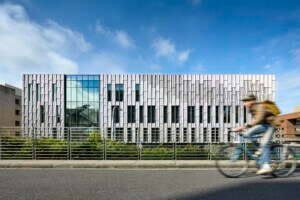The Seattle City Council unanimously voted yesterday to approve a long-planned increase in overall residential and commercial zoning densities in the city’s University District neighborhood. The plan will allow certain areas of the neighborhood around the campus of the University of Washington to rise up to between 240- and 320-feet in height and will mandate new developments set aside nine percent of new units as affordable.
The region is bubbling over with development and has absorbed roughly 700,000 new inhabitants between 2000 and 2014. Seattle is also home to a slew of tech companies like Amazon and—perhaps most importantly—recently passed a ballot initiative aimed at expanding the length of its transit system by a factor of five.
Though the change toward higher-density development has been controversial with some residents, it was strongly supported by housing activists from across the political spectrum. The zoning change is expected to bring roughly 5,000 new housing units across a broad swath of medium-to-low density areas surrounding the university. The University District—which will be connected to the region’s growing Sound Transit system in 2021 when the Northgate Link Extension opens through the neighborhood—is poised to act as a test run for Mayor Ed Murray’s plans to get developers to build additional affordable housing. It’s not a bad deal for the developers, either: The plan will neither require affordable units be built on site nor in the same neighborhood. If developers do not wish to build the affordable units themselves, they will be able to contribute funding so that the city’s Office of Housing can build them.
The new measure, called Mandatory Housing Affordability (MHA) is part of the city’s Housing Affordability and Livability Agenda (HALA) plan, which is focused around the Seattle 2035 Comprehensive Planning document, a guide that envisions a region-wide urban agglomeration collected around “urban villages” organized along the Sound Transit system. The HALA plan aims to generate up to 50,000 new housing units—20,000 of which would be affordable—across the city by 2025. Of those 20,000 affordable units, it is expected that MHA will generate about 6,300 units. For the University District, that means roughly 5,000 new units overall, including between 600 and 900 affordable apartments.
As the first section of the city rezoned under HALA, officials and the public will be watching how the neighborhood changes very closely. The up-zone measure was passed with a caveat allowing for it to be revisited in the future, depending on the nature of change in the area. The City of Seattle is expected to begin to rezone the entire city in 2018, with four other districts undergoing the rezoning process this year.










